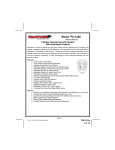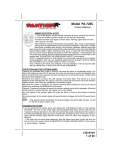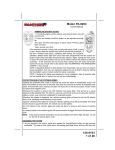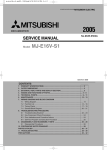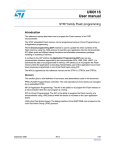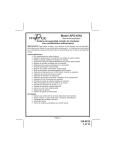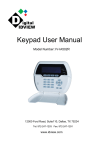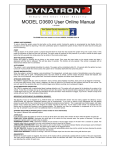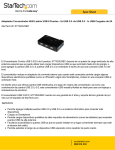Download Model APS-140 - AutoMobility
Transcript
Model APS-140 Owners Manual 3 Button Remote Security System With Anti-Hijack Feature Important: In order to provide you and your vehicle with the highest level of security, this system is equipped with an Anti Hi-Jack feature. The selectable Anti Hi-Jack mode and it's operation is described in this manual. Having a thorough working knowledge of your security system will afford you the highest level of personal protection. We urge you to read this manual completely to take advantage of all the features included with this security system. Features: 2 Three button Transmitters Three Channel Code Learning Receiver Negative Pulsed Door Lock Outputs Selectable Single Or Double Door Lock Output Pulse Selectable Ignition Control Door Lock/Unlock On/Off Selectable Passive Or Active Arming Selectable Passive Or Active Door Lock Selectable Anti-Hijack Mode On/Off Remote Control Operation Of Anti-Hijack Mode (See Programming) 8 Function LED Indicator Intrusion Zone Chirp With Memory Onboard Light Flash Relay Negative And Positive Door Trigger Inputs Additional Negative Trigger Input Single Tone Siren On-Board Multi Level Dual Stage Shock Sensor Options: Remote Trunk Release Vehicle Must Have Electric Trunk Release (May Required Relay) Remote Door Lock Control Of Existing Electric Door Lock Capable Of Operating Multiple Vehicles With Similar Audiovox Systems Starter Inhibit Circuit, Relay Required Remote Start Optional Module Required Remote Window Control Optional Module Required Page 1 128-8205 1 of 16 ARMING THE SYSTEM - ACTIVE 1. Turn off the engine, exit the vehicle, and close all doors, hood lid, and trunk lid. 2. Press and release the ARM / Lock button on the keychain transmitter. Red dash mounted LED begins to flash slowly. Parking Lights flash one time. Siren sounds one chirp. If the siren sounds 3 chirps, then you have left a door, trunk, or hood lid ajar. Simply close the opened entry point to provide full protection. If the siren did not sound when arming, then the chirps have been turned off, and you should refer to the section titled “ ELIMINATING THE ARM / DISARM CHIRPS “ in this manual. o Doors Lock - Optional SILENT ARMING - ACTIVE 1. Turn off the engine, exit the vehicle, and close all doors, hood lid, and trunk lid. 2. Press both buttons on the keychain transmitter. Red dash mounted LED begins to flash slowly. Parking Lights flash one time. Siren will not sound. If the siren sounds 3 chirps, then you have left a door, trunk, or hood lid ajar. Simply close the opened entry point to provide full protection. Doors Lock - Optional Note: Must be selected on during installation ARMING THE SYSTEM - PASSIVE ( AUTOMATIC ) 1. Turn off the engine, exit the vehicle, and close and lock all doors, hood lid, and trunk lid. Red dash mounted LED begins to flash rapidly, indicating 30 second passive arming has begun. 2. Opening any protected entry point during the 30 second passive arming cycle will immediately suspend automatic arming, and the 30 second passive arming cycle will re start when all doors are closed. At the end of the passive arming cycle; Red dash mounted LED begins to flash slowly. Parking Lights flash one time. Siren sounds one chirp Doors Lock - Optional Door locking during passive arming is a selectable feature. The alarm can be programmed to allow the doors to lock only when arming using the keychain transmitter, and they will not automatically lock during passive arming. PROTECTION WHILE THE SYSTEM IS ARMED Opening any protected door, hood, or trunk lid will cause the alarm to immediately sound. The alarm will continue to sound for 30 seconds, then stop and continue to monitor all protected entry points. If the thief left a door opened, the alarm will sound for six 30 second cycles, remain armed and ignore that triggered zone. Whenever the system is armed, the red dash mounted LED indicator will slowly flash. This serves as a visual deterrent to the potential thief. The LED is a very low current bulb, and will not cause the vehicle’s battery to drain, even when left unattended for extended periods. Whenever the system is triggered, the vehicle’s parking lights will flash for the full 30 second alarm cycle, attracting visual attention to the vehicle. Page 2 128-8205 2 of 16 Whenever the system is armed, the vehicle’s starting circuit will be bypassed. If the thief should choose to ignore the siren, the vehicle can not be started. Any strong impact to the vehicle's glass/body will cause the alarm to trigger for the full 30 second alarm cycle. A milder impact will cause the siren to emit a few short warning tones. DISARMING THE SYSTEM 1. As you approach the vehicle, press and release the UNLOCK / DISARM button on the keychain transmitter. Red dash mounted LED turns off. If passive arming is selected, the LED will start flashing rapidly, indicating that the system is re arming automatically. Open any door to suspend the automatic arming. Parking Lights flash two times. If the parking lights flashed three times, then the alarm was triggered in your absence. Before turning the key on, examine the LED to identify which zone was triggered. Siren sounds two chirps. If the siren sounds 4 chirps, then the alarm was triggered in your absence. Before turning the key on, examine the LED and refer to the INTRUSION WARNING SIGNALS section of this manual to identify which zone was triggered. If the siren did not sound when disarming, then the chirps have been turned off, and you should refer to the section titled “ ELIMINATING THE ARM / DISARM CHIRPS “ in this manual. Doors Unlock - Optional NOTE : Anytime the system is disarmed, the unit will rearm automatically unless a door is opened. This will occur regardless of the arming method selected. SILENT DISARMING 1. As you approach the vehicle, press both buttons on the keychain transmitter. Red dash mounted LED turns off. If passive arming was selected during the installation, then the LED will start flashing rapidly, indicating that the system is re arming automatically. Open any door to suspend the automatic arming. Parking Lights flash two times. If the parking lights flashed three times, then the alarm was triggered in your absence. Before turning the key on, examine the LED to identify which zone was triggered. Siren will not sound. If the siren sounds 4 chirps, then the alarm was triggered in your absence. Before turning the key on, examine the LED and refer to the INTRUSION WARNING SIGNALS section of this manual to identify which zone was triggered. Doors Unlock - Optional Note: Must be selected on during installation. INTRUSION WARNING SIGNALS This system will inform you if an intrusion attempt has occurred while you were away from the vehicle. If an intrusion attempt has occurred, the siren will chirp 4 times and the parking lights will flash 3 times when disarming the system. Enter the vehicle, and observe the red dash mounted LED to identify which zone was triggered. If the LED is flashing one time...pause...one time...pause...etc., then the shock sensor was Page 3 128-8205 3 of 16 activated in your absence. If the LED is flashing two times...pause...two times...pause...etc., then an intrusion attempt was made to a hood or trunk pin switch that was added to the system. If the LED is flashing three times...pause...three times...pause...etc., then an intrusion attempt was made through one of the vehicle’s doors. These intrusion warning indicators are stored in the system’s memory, and will only be erased when the ignition key is turned on. Valet Mode: The valet switch allows you to temporarily bypass all alarm functions, eliminating the need to hand your transmitter to parking attendants or garage mechanics. When the system is in valet mode, all alarm functions are bypassed, however the remote panic feature and remote door locks will remain operational. To use the valet mode, the system must first be disarmed either by using your keychain transmitter, or by operating the manual override sequence. 1. From the disarmed condition, turn the ignition key to the on position. 2. Press and hold the valet push-button switch until the dash mounted LED, (Light Emitting Diode) turns on. The LED will remain on as long as the system is in valet mode. 3. To return to normal operation, turn the ignition switch on, then. press and hold the push button switch until the LED turns off. NOTE : Always remember to return the system to the NON VALET mode, after servicing, to ensure that the vehicle remains protected at all times. MANUALLY OVERRIDING YOUR SYSTEM: Using The Valet / Manual Override Switch: Your Security System can be disarmed without the use of the keychain transmitter. This is necessary, since you will need the ability to operate your vehicle if the transmitter is lost or its battery fails. To override the system: 1. Open the vehicle door. The alarm will sound. 2. Turn the ignition key to the on position. 3. Within 10 seconds, press and release the valet push button switch. The alarm system will stop sounding and enter the disarmed mode. You can now start and operate the vehicle normally. Typically this override mode is used only if the transmitter has become inoperative. You may elect to enter the VALET mode until repair or replacement of the transmitter, after which, returning the system to the full operation mode is necessary. To do so, see the heading VALET SWITCH. ELIMINATING THE NORMAL ARM / DISARM CHIRPS As explained earlier in the manual, you can eliminate the chirps selectively any time you arm or disarm the system simply by pressing both transmitter buttons. If you find the normal arming and disarming chirps annoying, they can be turned off permanently, eliminating the need to press both buttons. To turn chirps off permanently, selectable features # 6 must be turned off in the feature programming section of the installation manual. Refer to this manual or consult with your installation technician to have this feature turned off. NOTE : Whenever the chirps are bypassed, the 4 chirp intrusion indicator and 3 chirp defective zone indicator will always operate. Since these are important warnings to you that something has happened, they cannot be eliminated. Arming Without Shock: This system has the ability to allow the sensor to be defeated, from the transmitter, entirely for one arming cycle. To eliminate the sensor for one arming cycle: Press the lock button of the transmitter, siren chirps once, and immediately press the lock button a second time, siren chirps one long chirp. The system is armed but the shock sensor is bypassed for one arming cycle. Page 4 128-8205 4 of 16 REMOTE PANIC OPERATION The ARM or DISARM button on your keychain transmitter also functions as a panic switch for use in emergency situations. To use remote panic, 1. Press and hold the ARM or DISARM button on the keychain transmitter for 3 or more seconds. The alarm will immediately sound. 2. To stop the alarm, press and hold the ARM or DISARM button on the transmitter again for 3 seconds. If the button is not pressed, the alarm will automatically stop after 30 seconds. NOTE: Pressing the Trunk button of the transmitter while in the panic mode will cause the sire n to immediately stop sounding. ADDITIONAL REMOTE FUNCTION ( CHANNEL 2 ) This security system has an additional feature that can be connected to a number of different optional accessories. Some of the more common uses for this channel are; Remote Trunk Release Remote Car Starter Remote Window Closure To activate the optional accessory, press and hold the Trunk/Key button on the keychain transmitter for two seconds. Anti Hi-Jack Mode Operation: 1. a) With the ignition switch on, and the doors closed, press and hold both the Lock & Unlock buttons of the transmitter for 2 second to initiate the antihijack mode. The parking lights will turn on for 1.5 seconds to indicate the mode was initiated. (Typically used when the operator is evicted from the vehicle to initiate the antihijack mode. b) If while the ignition is on, and a door is opened and then all doors are closed, the unit will enter the antihijack mode. The parking lights will turn on for 1.5 seconds to indicate the mode was initiated. Automatic Anti-hijack mode. 2. a) 60 seconds after initiation, the siren will begin to sound and the parking lights will begin to flash. 3. a) 90 seconds after initiation, the starter inhibit circuit, (when installed) will be activated, the siren and lights will continue until the battery is exhausted, or until the unit is reset. NOTE: If you are the unfortunate victim of a vehicle Hi-Jack, for your personal safety, it is best to leave the vehicle as quickly as possible. Never attempt to oppose the thief in any way. If the thief prevents you from leaving the vehicle, disarm the Hi-Jack feature to prevent the system from sounding while you are in the presence of your captor. Once you exit the vehicle, opening and then closing the door will initiate the Hijack feature the system will go through the cycles mentioned above. Once the engine is turned off, it cannot be restarted if the optional Starter Inhibit Circuit is install. The unit will continue to make noise from the siren or the horn and the lights will continue to flash until the system is reset, or until the battery is exhausted. Disarming The Hi-Jack Feature: Anytime after the Hi-Jack mode has been triggered, the circuit can be disarmed simply by: 1) Turn the ignition switch from off to on 2) Within 10 seconds of 1, press and release the push-button override switch. Depressing this switch one time will cause the security system to reset the Hi-Jack mode. The circuit will not trigger again unless the door is opened and then closed while the vehicle is running. Car Locator: Anytime during the armed mode, if the Lock button is pressed within range of the vehicle, the siren will chirp 6 times and the parking lights will flash 12 times allowing easy location of the vehicle in a crowded parking light. Page 5 128-8205 5 of 16 Transmitters Included With This Kit: The transmitters are programmable and at times it may become necessary to replace transmitters if they become broken or if they are stolen. If this is the case, order replacement transmitters from Audiovox Customer Service @ 1800-645-4994. The transmitters packaged with this kit are 140TX. To Program new or replacement transmitters: 1. Enter the vehicle, and turn the ignition key to the “on” position. 2. Press and release the valet/override/program push button switch 3 times. 3. The dash LED will flash one time and the siren will “chirp” 1 time indicating the system is ready to accept programming for channel 1Arm/Disarm, Lock/Unlock and Panic. 4. Press and hold the lock button of the first transmitter until the parking lights flash and a long chirp is heard from the siren Repeat for each transmitter to be programmed. Note a maximum of 4 transmitters can be programmed. Turn the ignition switch off or allow 15 seconds of inactivity to exit the transmitter program mode. By completing the above, all three buttons of the transmitters are programmed into their default location. Lock = Lock / Arm, & Panic Unlock = Unlock / Disarm & Panic Trunk = Trunk Release & Panic Cancel, Press & Hold 2.5 seconds to release trunk, Press while Panic Sounding cancel panic immediately. Battery Replacement: Use CR2032 or equivalent. 1) Using a 0 Point Phillips Screwdriver, remove the screw from the back of the case where indicated by the arrow. 2) Carefully separate the top case from the bottom. 3) Slide the discharged battery from under the clip in the direction shown. 4) Properly dispose of the discharged battery. 5) Replace with a new CR2032 or equivalent battery. 6) Carefully align and snap closed the transmitter case. 7) Reinstall the screw removed in step #1. Page 6 128-8205 6 of 16 ORDER FORM FOR 140TX Transmitter Attention: Transmitter Ordering Department Important: To help us expedite your order, please print all of the information legibly and mail this form and your payment according to the instructions below. Indicate the pad number of your transmitter selected from the pads shown above. Note: Transmitter model number found on back of case. 1)Name: _______________________________________ 2)Address: ______________________________________ 3) City: ________________ State: _____ Zip Code: ________ 4) Telephone Number: (_____) _______________ 5) Total Number Of Transmitters Required: Cost Per Transmitter is: $65.00 Multiply By Number Of Transmitters X ______ 6) Enter Total Amount Enclosed _________________ (New York State Residents must include the appropriate sales tax) 7) Method of Payment: Mastercard Visa Check or Money Order (do not send cash) Make Checks Payable To Audiovox Corporation CreditCard Number: _________________________________ Credit Card Expiration Date: ____ / _____ / _____ 8) Mail this form along with your payment to: Credit card purchasers can order additional or replacement transmitters by phone. Simply dial 1 - 800 - 645 - 4994, and follow the instructions from the operator interface. Audiovox Electronics Corp., 150 Marcus Blvd., Hauppauge, N.Y., 11788 Attn.: TRANSMITTER DEPARTMENT Page 7 128-8205 7 of 16 APS-140 SYSTEM FUNCTIONS AT A GLANCE DASH LED INDICATIONS Rapid Flashing Slow Flashing Off On Solid 1 Flash Pause, etc... 2 Flash Pause, etc... 3 Flash Pause, etc... = = = = = = = Passive Arming Armed Disarmed Valet Mode Shock Sensor Hood Or Trunk Doors SIREN CHIRP INDICATIONS 1 Chirp * = Arm 2 Chirps * = Disarm 3 Chirps = Arm With Zone Active 4 Chirps = Disarm After Intrusion * These Chirp Can Be Selected Off In Programming Or With The Transmitter LIGHT FLASH INDICATIONS 1 Flash 2 Flashes 3 Flashes = = = Arm Disarm Disarm After Intrusion Your System Has These Features Activated Remote Lock / Unlock Automatic Lock / Unlock With Ignition Passive Arming Passive Locking Anti Hi-Jack Active Vehicle Horn Operational Siren Operational Page 8 128-8205 8 of 16 Modelo APS-140 Manual del propietario Sistema de seguridad remoto de 3 botones Con función antirrobo Importante: A fin de proporcionarle el mayor nivel de seguridad a usted y a su vehículo, este sistema está equipado con la función antirrobo. Este manual describe el modo antirrobo seleccionable y su funcionamiento. El detallado conocimiento del funcionamiento de su sistema de seguridad le proporcionará el mayor nivel de protección personal. Es esencial que lea atentamente este manual para aprovechar todas las funciones que incluye el sistema de seguridad. Funciones: 2 transmisores de tres botones Receptor de aprendizaje de código de tres canales Salidas de bloqueo de puerta con pulso negativo Opción de pulso de salida de bloqueo de puerta simple o doble Opción de encendido/apagado de bloqueo/desbloqueo de puerta de control de arranque Opción de armado pasivo o activo Opción de bloqueo de puerta pasivo o activo Opción de encendido/apagado del modo antirrobo Operación del modo antirrobo por control remoto (ver Programación) LED indicador de 8 funciones Chirrido de zona de intrusión con memoria Relé de parpadeo de luz del tablero Entradas de disparador de puerta negativa y positiva Entrada adicional de disparador negativa Sirena de tono simple Sensor de movimiento de etapa dual de nivel múltiple en tablero Opciones: El vehículo con liberación remota del baúl debe tener liberación de baúl eléctrica (puede requerir relé) Control remoto de bloqueo de puerta del bloqueo de puerta eléctrico existente Capaz de operar múltiples vehículos con sistemas Audiovox similares Circuito inhibidor de arranque, requiere relé Módulo opcional de arranque remoto requerido Módulo opcional de control de ventanilla requerido Página 1 128-8205 9 of 16 ARMADO DEL SISTEMA - ACTIVO 1. Apague el motor, salga del vehículo y cierre todas las puertas, el capó y el baúl. 2. Presione y suelte el boón ARM / Lock del transmisor de pulso. El LED rojo montado al tablero comienza a parpadear lentamente. Las luces de parqueo parpadean una vez. La sirena emite un chirrido. Si la sirena emite 3 chirridos, dejó una puerta, el baúl o el capó entreabiertos. Cierre el punto de entrada abierto para proporcionar plena protección. Si la sirena no emite ningún sonido durante el armado, el sonido de la sirena está desactivado. Consulte la sección “ELIMINACIÓN DE LOS CHIRRIDOS DE ARMADO/ DESARMADO“ de este manual. Bloqueo de puertas - opcional ARMADO SILENCIOSO - ACTIVO 1. Apague el motor, salga del vehículo y cierre todas las puertas, el capó y el baúl. 2. Presione los botones del transmisor de pulso. El LED rojo montado al tablero comienza a parpadear lentamente. Las luces de parqueo parpadean una vez. La sirena no emitirá ningún sonido. Si la sirena emite 3 chirridos, dejó una puerta, el baúl o el capó entreabiertos. Cierre el punto de entrada abierto para proporcionar plena protección. Bloqueo de puertas - opcional Nota: Debe seleccionarse durante la instalación ARMADO DEL SISTEMA - PASIVO (AUTOMÁTICO) 1. Apague el motor, salga del vehículo y cierre y bloquee todas las puertas, el capó y el baúl. El LED rojo ontado al tablero comienza a parpadear rápidamente indicando que se ha iniciado el armado pasivo de 30 segundos. 2. Si abre alguno de los puntos de entrada protegidos durante el ciclo de 30 segundos de armado pasivo se suspenderá automáticamente el armado y el ciclo de armado pasivo de 30 segundos se reiniciará cuando todas las puertas estén cerradas. Al finalizar el ciclo de armado pasivo; El LED rojo montado en el tablero comienza a parpadear lentamente. Las luces de parqueo parpadean una vez. La sirena emite un chirrido. Bloqueo de puertas - opcional El bloqueo de las puertas durante el armado pasivo es una función seleccionable. La alarma puede programarse para permitir que las puertas se bloqueen sólo cuando se procede al armado utilizando el transmisor de pulso y no se bloquearán automáticamente durante el armado pasivo. PROTECCIÓN MIENTRAS EL SISTEMA ESTÁ ARMADO La apertura de cualquier puerta, capó o baúl protegido hará que la alarma suene de inmediato. La alarma continuará sonando por 30 segundos y se detendrá y continuará controlando todos los puntos de entrada protegidos. Si el ladrón deja una puerta abierta, la alarma sonará durante seis ciclos de 30 segundos, continuará armada e ignorará la zona disparada. Cuando el sistema está armado, el LED rojo montado al tablero parpadeará lentamente. Esto actúa como método visual para disuadir al potencial ladrón. El LED es una bombilla de muy baja corriente que no ocasionará que la batería se agote, incluso si se deja encendido por mucho tiempo. Cuando se dispara el sistema, las luces de parqueo del vehículo parpadearán durante el ciclo completo de alarma de 30 segundos, atrayendo la atención visual hacia el vehículo. Página 2 128-8205 10 of 16 Cuando el sistema está armado, se puenteará el circuito de arranque del vehículo. Si el ladrón opta por ignorar la sirena, el vehículo no arrancará. Cualquier impacto fuerte sobre el vidrio/la carrocería del vehículo hará que la alarma dispare el ciclo completo de alarma de 30 segundos. Un impacto más leve provocará que la sirena emita unos tonos de advertencia un poco más cortos. DESARME DEL SISTEMA 1. Al acercarse al vehículo, presione y suelte el botón UNLOCK/DISARM (DESBLOQUEO/ DESARME) del transmisor de pulso. El LED rojo montado al tablero se apaga. Si se selecciona el armado pasivo, el LED comenzará a parpadear rápidamente, indicando que el sistema se está rearmando automáticamente. Para suspender el armado automático, abra cualquier puerta. Las luces de parqueo parpadean dos veces. Si las luces de parqueo parpadean tres veces, la alarma se disparó en su ausencia. Antes de encender el vehículo, examine el LED para verificar qué zona disparó la alarma. La sirena emite dos chirridos. Si la sirena emite 4 chirridos, la alarma se disparó en su ausencia. Antes de encender el vehículo, examine el LED y consulte la sección SEÑALES DEADVERTENCIADE INTRUSIÓN de este manual para identificar qué zona disparó la alarma. Si la sirena no emite ningún sonido durante el armado, los chirridos están apagados. Consulte la sección “ELIMINACIÓN DE LOS CHIRRIDOS DE ARMADO/DESARMADO“ de este manual. Desbloqueo de puertas - opcional NOTA: Siempre que el sistema esté desarmado, la unidad se rearmará automáticamente salvo que haya una puerta abierta. Esto se producirá independientemente del método de armado seleccionado. DESARME SILENCIOSO 1. Al acercarse al vehículo, presione ambos botones del transmisor de pulso. El LED rojo montado al tablero se apaga. Si se selecciona el armado pasivo durante la instalación, el LED comenzará a parpadear rápidamente, indicando que el sistema se está rearmando automáticamente. Para suspender el armado automático, abra cualquier puerta. Las luces de parqueo parpadean dos veces. Si las luces de parqueo parpadean tres veces, la alarma se disparó en su ausencia. Antes de encender el vehículo, examine el LED para verificar qué zona disparó la alarma. La sirena no emitirá ningún sonido. Si la sirena emite 4 chirridos, la alarma se disparó en su ausencia. Antes de encender el vehículo, examine el LED y consulte la sección SEÑALES DEADVERTENCIADE INTRUSIÓN de este manual para identificar qué zona disparó la alarma. Desbloqueo de puertas - opcional Nota: Debe seleccionarse durante la instalación. SEÑALES DE ADVERTENCIA DE INTRUSIÓN Este sistema le informará si se ha producido un intento de intrusión mientras se encontraba lejos del vehículo. En caso de haberse producido un intento de intrusión, la sirena emitirá 4 chirridos y las luces de parqueo parpadearán 3 veces mientras se desarma el sistema. Ingrese en el vehículo y observe el LED rojo montado al tablero para identificar la zona que disparó la alarma. Si el LED parpadea uno vece... hace una pausa... uno vece... pausa... etc. el sensor de moviemiento se activó en su ausencia. Si el LED parpadea dos veces... efectúa una pausa... dos veces... pausa, etc. el intento de intrusión ocurrió en el pulsador de clavija del capó o baúl agregado al sistema. Página 3 128-8205 11 of 16 Si el LED parpadea tres veces... hace una pausa... tres veces... pausa... etc. el intento de intrusión tuvo lugar en alguna de las puertas del vehículo. Estos indicadores de advertencias de intrusión se almacenan en la memoria del sistema y sólo se borrarán al encender el contacto. Modo valet: El interruptor de valet le permite puentear temporariamente las funciones de la alarma, eliminando la necesidad de entregar el transmisor a los encargados del parqueo o del taller mecánico. Cuando el sistema está en el modo valet, todas las funciones de la alarma se puentean. No obstante, la función de urgencia remota y de bloqueo remoto de puertas seguirán funcionando. Para usar el modo valet, el sistema debe desarmarse en primer lugar mediante el transmisor de pulso o la secuencia de anulación manual de operación. 1. Una vez desarmado, active el contacto. 2. Mantenga presionado el interruptor de valet hasta que el LED (diodo emisor de luz) montado al tablero se encienda. El LED permanecerá encendido en tanto el sistema permanezca en el modo valet. 3. Para volver al modo de operación normal, active el contacto y luego mantenga presionado el interruptor hasta que el LED se apague. NOTA: Recuerde siempre volver al modo NO VALET del sistema luego de efectuar la reparación, a fin de garantizar que el vehículo permanezca protegido todo el tiempo. ANULACIÓN MANUAL DEL SISTEMA: Por medio del pulsador de cancelación de valet/manual: Su sistema de seguridad puede desarmarse sin necesidad de utilizar el transmisor de pulso. Esto es necesario dado que debe poder operar el vehículo si se pierde el transmisor o se agotan las baterías. Para anular el sistema: 1. Abra la puerta del vehículo. Sonará la alarma. 2. Gire la llave hacia la posición de contacto. 3. Dentro de los 10 segundos, presione y suelte el interruptor de valet. El sistema de alarma dejará de sonar e ingresará en el modo desarmado. Ya puede arrancar y operar el vehículo normalmente. Normalmente, este modo de anulación se utiliza sólo si el transmisor no está operativo. Puede elegir ingresar en el modo VALET hasta que haya reparado o reemplazado el transmisor y luego volver al modo de operación completa del sistema si fuera necesario. Para hacerlo, consulte la sección INTERRUPTOR DE VALET. ELIMINACIÓN DE LOS CHIRRIDOS DE ARMADO/DESARMADO NORMAL Como se explica en este manual, tiene la opción de eliminar los chirridos durante el armado o desarmado del sistema con sólo presionar ambos botones del transmisor. Si le molestan los chirridos de armado y desarmado, desactívelos de forma permanente sin necesidad de tener que presionar ambos botones. Para desactivar los chirridos de forma permanente, apague las funciones seleccionables N.º 6 de la sección de programación de funciones del manual de instalación. Consulte este manual o con un profesional de instalaciones sobre cómo desactivar esta función. NOTA: Cuando se puentean los chirridos, el indicador de intrusión de 4 chirridos y el indicador de zona defectuosa de 3 chirridos permanecerán operativos. Dado que estas advertencias indican que sucedió algo importante, no pueden eliminarse. Armado sin movimiento: Este sistema tiene la capacidad de engañar al sensor, desde el transmisor, durante un ciclo de armado completo. Para eliminar el sensor para un ciclo de armado: Presione el botón de bloqueo del transmisor -la sirena suena una vez- y presione inmediatamente el botón de bloqueo una segunda vez -la sirena emite un chirrido largo. El sistema está armado pero el sensor de movimiento está puenteado para un ciclo de armado. Página 4 128-8205 12 of 16 OPERACIÓN REMOTA DE URGENCIA El botón ARM o DESARM del transmisor de pulso también funciona como pulsador de urgencia en situaciones de emergencia. Para usarlo como pulsador de urgencia: 1. Mantenga presionado el botón ARM o DISARM del transmisor de pulso por 3 segundos o más. Sonará la alarma al instante. 2. Para detener la alarma, mantenga nuevamente presionado el botón ARM o DISARM del transmisor de pulso por 3 segundos. Si el botón no está presionado, la alarma se detendrá automáticamente transcurridos los 30 segundos. NOTA: Si presiona el botón Trunk del transmisor en el modo urgencia, la sirena automáticametne dejará de sonar. FUNCIÓN REMOTA ADICIONAL (CANAL 2 ) El sistema de seguridad tiene una función adicional que puede conectarse a diversos accesorios opcionales. Algunos de los usos más comunes de este canal: Liberación remota del baúl Arranque remoto del automóvil Cierre remoto de ventanas Para activar el accesorio opcional, mantenga presionado el botón Trunk/Key del transmisor de pulso por dos segundos. Operación en el modo antirrobo: 1. a) Con el arranque encendido -y las puertas cerradas- mantenga presionados los botones Lock y Unlock del transmisor por 2 segundos para iniciar el modo antirrobo. Las luces de parqueo se encenderán por 1,5 segundos para indicar que se inició el modo. (Normalmente se utiliza cuando se hace salir al conductor del vehículo para iniciar el modo antirrobo. b) Cuando el arranque está encendido y una puerta abierta y luego todas las puertas cerradas, la unidad iniciará el modo antirrobo. Las luces de parqueo se encenderán por 1,5 segundos para indicar que se inició el modo. Modo antirrobo automático. 2. a) 60 segundos después del inicio, la sirena comenzará a sonar y las luces de parqueo a parpadear. 3. a) 90 segundos después del inicio, el circuito de inhibición de arranque -si está instaladose activará y luego la sirena y las luces continuarán encendidas hasta que se agote la batería o se reinicie la unidad. NOTA: En caso de que le toque ser la víctima de un robo de vehículo, para seguridad personal, abandone el vehículo tan pronto sea posible. Nunca intente confrontar al ladrón. Si el ladrón impide que abandone el vehículo, desarme la función de robo para evitar que el sistema suene mientras está en presencia del captor. Una vez abandonado el vehículo, con sólo abrir y cerrar la puerta iniciará la función de robo y el sistema procederá con los ciclos antes mencionados. Una vez apagado el motor, no podrá volver a arrancar si tiene instalado el Circuito de Inhibición de Arranque. La unidad continuará haciendo ruido con la sirena o la bocina y las luces continuarán parpadeando hasta que reinicie el sistema o hasta que se agote la batería. Desarme de la función de robo: En cualquier momento, luego de activar el modo de robo, podrá desarmar el circuito con sólo: 1) Apagar el arranque 2) Dentro de los 10 segundos de haber efectuado la operación anterior, mantenga presionado el pulsador de anulación. Al soltar una vez el pulsador el sistema de seguridad se reiniciará el modo robo. El circuito no se disparará nuevamente salvo que se abra y cierre la puerta mientras el vehículo está en funcionamiento. Localización del vehículo: En cualquier momento durante el modo de armado, si mantiene presionado el botón Lock dentro del rango de alcance en el que se encuentra el vehículo, la sirena sonará 6 veces y las luces de parqueo parpadearán hasta 12 veces permitiendo la fácil localización del vehículo Página 5 128-8205 13 of 16 en un estacionamiento con muchos vehículos. Transmisores incluidos con este kit: Los transmisores son programables y en algunos casos podría ser necesario reemplazar los transmisores si se rompen o son hurtados. En tal caso, solicite transmisores de reemplazo al Servicio de Atención al Cliente de Audiovox llamando al 1800-645-4994. Los transmisores que se suministran con este kit son 140TX. Para programar transmisores nuevos o reemplazos: 1. Ingrese en el vehículo y gire la llave de arranque a la posición de encendido. 2. Presione y suelte el pulsador de valet/anulación/programación 3 veces. 3. El LED del tablero parpadeará una vez y la sirena emitirá un chirrido indicando que el sistema está listo para recibir la programación del canal 1Arm/Disarm, Lock/Unlock y Panic. 4. Mantenga presionado el botón de bloqueo del primer transmisor hasta que las luces de parqueo parpadeen y la sirena emita un chirrido largo. Repita estos pasos para cada transmisor que desea programar. Tenga en cuenta que puede programar hasta 4 transmisores. Encienda el contacto y espere 15 segundos de inactividad para salir del modo de programación del transmisor. Al completar el paso anterior, los tres botones de los transmisores quedarán programados con sus ubicaciones predeterminadas. Lock = bloqueo, armado y urgencia Unlock = desbloqueo, desarme y urgencia Trunk = liberación del baúl y cancelación del modo urgencia; mantenga presionado 2,5 segundos para liberar el baúl; presione mientras se cancela el sonido de urgencia. Reemplazo de batería: Use CR2032 o similar. 1) Con un destornillador Phillip 0, extraiga el tornillo de la parte posterior de la cubierta según indica la flecha. 2) Separe cuidadosamente la parte superior de la inferior. 3) Deslice la batería descargada extrayéndola del gancho en la dirección que indica la ilustración. 4) Deseche la batería descargada como corresponde. 5) Reemplace con una nueva batería CR2032 o similar. 6) Alinee cuidadosamente, deslice hasta trabar y cierre la cubierta del transmisor. 7) Vuelva a colocar el tornillo que extrajo en el paso 1. Deslice la batería hacia fuera del gancho. Vuelva a instalar invertidos, con el terminal positivo hacia arriba, lejos del circuito impreso. Página 6 128-8205 14 of 16 FORMULARIO DE SOLICITUD DE Transmisor 140TX Atención: Transmitter Ordering Department Importante: Para facilitar su pedido, complete el formulario con letra clara y envíe este formulario y el pago correspondiente según las instrucciones que se incluyen a continuación. Indique el código de embalaje de su transmisor según los números que se muestran abajo. Nota: Número de modelo del transmisor al dorso de la cubierta. 1) Nombre: _______________________________________ 2) Dirección: ______________________________________ 3) Ciudad: ________________ Estado: _____ Código postal: ________ 4) Número de teléfono: (_____) _______________ 5) Cantidad total de transmisores solicitados: Costo por transmisor: $65.00 Multiplicar por la cantidad de transmisores X ______ 6) Indicar monto total enviado _________________ (Los residentes del estado de New York deben incluir el impuesto a la venta correspondiente) 7) Forma de pago: Mastercard Visa Cheque o giro postal (no envíe efectivo) Los cheques se emitirán a la orden de Audiovox Corporation Tarjeta de crédito número: _________________________________ Fecha de vencimiento de la tarjeta de crédito: ____ / _____ / _____ 8) Envíe este formulario junto con su pago a: Quienes compren con tarjeta de crédito podrán efectuar pedidos adicionales o reemplazo de transmisores por teléfono. Simplemente marque 1 - 800 - 645 - 4994 y siga las instrucciones del operador. Audiovox Electronics Corp., 150 Marcus Blvd., Hauppauge, NY, 11788 Atención: TRANSMITTER DEPARTMENT Página 7 128-8205 15 of 16 © 2007 Audiovox Electronics Corp., 150 Marcus Blvd., Hauppauge, NY, 11788 128-8205 128-8205 16 of 16

















